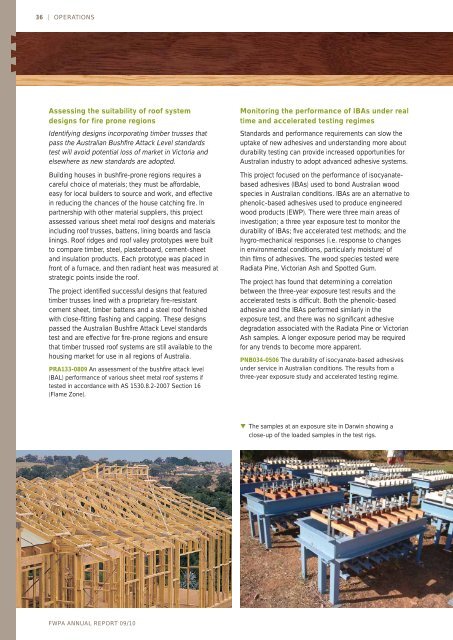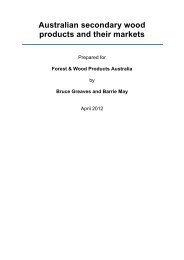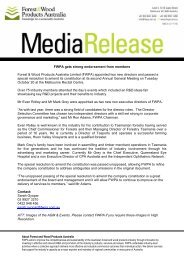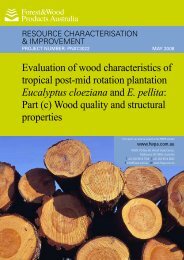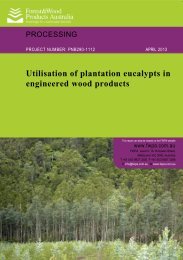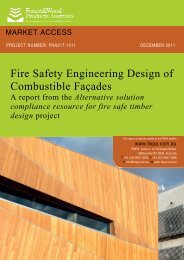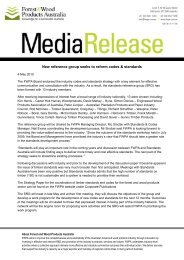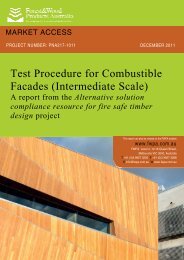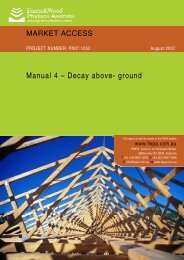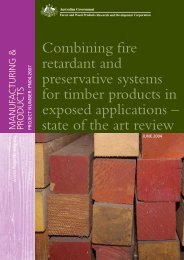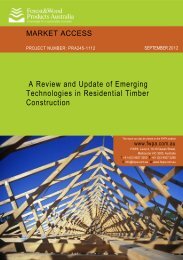ANNUAL REPORT 09/10 - Forest and Wood Products Australia
ANNUAL REPORT 09/10 - Forest and Wood Products Australia
ANNUAL REPORT 09/10 - Forest and Wood Products Australia
You also want an ePaper? Increase the reach of your titles
YUMPU automatically turns print PDFs into web optimized ePapers that Google loves.
36 | OPERATIONS<br />
Assessing the suitability of roof system<br />
designs for fire prone regions<br />
Identifying designs incorporating timber trusses that<br />
pass the <strong>Australia</strong>n Bushfi re Attack Level st<strong>and</strong>ards<br />
test will avoid potential loss of market in Victoria <strong>and</strong><br />
elsewhere as new st<strong>and</strong>ards are adopted.<br />
Building houses in bushfi re-prone regions requires a<br />
careful choice of materials; they must be affordable,<br />
easy for local builders to source <strong>and</strong> work, <strong>and</strong> effective<br />
in reducing the chances of the house catching fi re. In<br />
partnership with other material suppliers, this project<br />
assessed various sheet metal roof designs <strong>and</strong> materials<br />
including roof trusses, battens, lining boards <strong>and</strong> fascia<br />
linings. Roof ridges <strong>and</strong> roof valley prototypes were built<br />
to compare timber, steel, plasterboard, cement-sheet<br />
<strong>and</strong> insulation products. Each prototype was placed in<br />
front of a furnace, <strong>and</strong> then radiant heat was measured at<br />
strategic points inside the roof.<br />
The project identifi ed successful designs that featured<br />
timber trusses lined with a proprietary fi re-resistant<br />
cement sheet, timber battens <strong>and</strong> a steel roof fi nished<br />
with close-fi tting fl ashing <strong>and</strong> capping. These designs<br />
passed the <strong>Australia</strong>n Bushfi re Attack Level st<strong>and</strong>ards<br />
test <strong>and</strong> are effective for fi re-prone regions <strong>and</strong> ensure<br />
that timber trussed roof systems are still available to the<br />
housing market for use in all regions of <strong>Australia</strong>.<br />
PRA133-08<strong>09</strong> An assessment of the bushfi re attack level<br />
(BAL) performance of various sheet metal roof systems if<br />
tested in accordance with AS 1530.8.2-2007 Section 16<br />
(Flame Zone).<br />
FWPA <strong>ANNUAL</strong> <strong>REPORT</strong> <strong>09</strong>/<strong>10</strong><br />
Monitoring the performance of IBAs under real<br />
time <strong>and</strong> accelerated testing regimes<br />
St<strong>and</strong>ards <strong>and</strong> performance requirements can slow the<br />
uptake of new adhesives <strong>and</strong> underst<strong>and</strong>ing more about<br />
durability testing can provide increased opportunities for<br />
<strong>Australia</strong>n industry to adopt advanced adhesive systems.<br />
This project focused on the performance of isocyanatebased<br />
adhesives (IBAs) used to bond <strong>Australia</strong>n wood<br />
species in <strong>Australia</strong>n conditions. IBAs are an alternative to<br />
phenolic-based adhesives used to produce engineered<br />
wood products (EWP). There were three main areas of<br />
investigation; a three year exposure test to monitor the<br />
durability of IBAs; fi ve accelerated test methods; <strong>and</strong> the<br />
hygro-mechanical responses (i.e. response to changes<br />
in environmental conditions, particularly moisture) of<br />
thin fi lms of adhesives. The wood species tested were<br />
Radiata Pine, Victorian Ash <strong>and</strong> Spotted Gum.<br />
The project has found that determining a correlation<br />
between the three-year exposure test results <strong>and</strong> the<br />
accelerated tests is diffi cult. Both the phenolic-based<br />
adhesive <strong>and</strong> the IBAs performed similarly in the<br />
exposure test, <strong>and</strong> there was no signifi cant adhesive<br />
degradation associated with the Radiata Pine or Victorian<br />
Ash samples. A longer exposure period may be required<br />
for any trends to become more apparent.<br />
PNB034-0506 The durability of isocyanate-based adhesives<br />
under service in <strong>Australia</strong>n conditions. The results from a<br />
three-year exposure study <strong>and</strong> accelerated testing regime.<br />
The samples at an exposure site in Darwin showing a<br />
close-up of the loaded samples in the test rigs.


